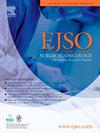Risk of distant metastasis after local excision for near-complete response versus salvage surgery for local regrowth in rectal cancer: Results from an international registry
IF 3.5
2区 医学
Q2 ONCOLOGY
引用次数: 0
Abstract
Aim
Watch and Wait (WW) strategy is currently used for mid/low rectal adenocarcinoma after neoadjuvant treatment (NAT). Local regrowth (LR) is a well-known risk, but its impact on distant metastasis (DM) is increasingly debated. This study aimed to assess the rate of DM after local excision (LE) for near-complete clinical response (ncCR) at restaging versus salvage surgery for regrowth following WW.
Method
Retrospective analysis of DM rates from a prospective international registry, comparing patients with ncCR after NAT who underwent LE and patients with initial complete clinical response (cCR) and WW strategy, who underwent salvage surgery for regrowth. The primary endpoint was the 5-year distant metastasis-free survival (5y-DMFS). Univariate/Multivariate analysis were performed to identify risk factors of DM.
Results
Among 138 patients included, 59 had LE for ncCR and 79 had salvage surgery after regrowth including TME (n = 23), APR (n = 30) and LE (n = 26). The 5y-DMFS was lower in patients with surgery at regrowth, 71 % vs. 93 % (p = 0.006). LR was the only independent risk factor associated with DM (OR:3.89; 95 % CI:1.34–11.25; p = 0.012). When only patients managed by salvage LE for LR are considered, 5y-DMFS was equivalent to LE at restaging (87 vs. 93; p = 0.442).
Conclusion
Patients with rectal cancer undergoing LE for ncCR after NAT have a significantly lower rate of DM compared to patients undergoing salvage surgery after LR within WW approach. Patients managed by LE for regrowth may represent a distinct subgroup where the risk of subsequent DM is equivalent to patients managed by LE at restage.
观察和等待(WW)策略目前用于新辅助治疗(NAT)后的中/低位直肠腺癌。局部生长(LR)是一个众所周知的风险,但其对远处转移(DM)的影响却引起了越来越多的争论。本研究旨在评估在重新分期时因接近完全临床反应(ncCR)而进行局部切除(LE)后的DM发生率与因WW后再生而进行挽救手术后的DM发生率。方法对前瞻性国际登记处的DM发生率进行回顾性分析,比较接受LE的NAT后ncCR患者与接受挽救手术治疗再生的初始完全临床反应(cCR)和WW策略患者。主要终点是5年无远处转移生存率(5y-DMFS)。结果138例患者中,59例因ncCR接受了LE手术,79例在再生后接受了挽救手术,包括TME(23例)、APR(30例)和LE(26例)。在再生时进行手术的患者的 5y-DMFS 较低,为 71% 对 93%(p = 0.006)。LR是唯一与DM相关的独立风险因素(OR:3.89; 95 % CI:1.34-11.25; p = 0.012)。结论NAT后接受LE治疗ncCR的直肠癌患者与WW方法中LR后接受挽救手术的患者相比,DM发生率明显较低。接受LE治疗再生的患者可能代表了一个独特的亚组,其后续DM的风险与接受LE治疗复位的患者相当。
本文章由计算机程序翻译,如有差异,请以英文原文为准。
求助全文
约1分钟内获得全文
求助全文
来源期刊

Ejso
医学-外科
CiteScore
6.40
自引率
2.60%
发文量
1148
审稿时长
41 days
期刊介绍:
JSO - European Journal of Surgical Oncology ("the Journal of Cancer Surgery") is the Official Journal of the European Society of Surgical Oncology and BASO ~ the Association for Cancer Surgery.
The EJSO aims to advance surgical oncology research and practice through the publication of original research articles, review articles, editorials, debates and correspondence.
 求助内容:
求助内容: 应助结果提醒方式:
应助结果提醒方式:


